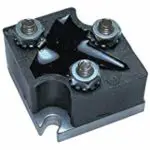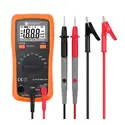Why Your Boat Battery Keeps Dying and What You Can Do

If your boat battery keeps dying there could be many reasons for this problem. One of the more common reasons with an outboard boat engine is that the rectifier is not working correctly. Just like the alternator on a car, the rectifier is supposed to charge your battery while the engine is running. If this little unit is not working correctly, then it won’t be able to convert the AC (Alternate Current) to DC (Direct Current).
Another reason your boat battery might be dying even when you are not using your boat is that there is something on board that is drawing power from the battery, such as a light turned on.
It could be as simple as a dead cell in the battery, and won’t hold much of a charge. In this case, you would need to replace the battery. You can take the battery into an auto shop to have it load tested.
How Do You Change a Bad Rectifier?
Replacing a rectifier is reasonably straightforward, and it is something you can do yourself either in your driveway or garage. I found a very helpful video on Youtube that walks you through the whole process. I’ll include a link to that video below.
How to Check a Boat Battery That Keeps Dying
There could be something drawing the power that you are not aware of, such as perhaps a light switch is left on, or something as silly as the radio turned on with the volume turned all the way down. There is a way to check the battery and see if it is drawing power
- Remove the battery cables and set those aside.
- Using a Digital Multimeter you want to set the lead on your amperage and move it to the amp scale. Check Amazon for the latest price.
- From the negative battery, post-connect the black lead.
- Touch the red lead to the positive battery post between the screw and the post itself.
- You should check with your owners manual at what the amp reading should be.
- Once you have your reading on the Digital Multimeter and you’ve confirmed it is drawing extra power, this is when you can begin to troubleshoot the problem. While still holding the leads to the battery:
- Carefully one at a time, start removing fuses and keep an eye on the amp readout until it drops down. Once it drops, then you’ve found the source drawing the power.
- You can try removing electronics in the same way you would remove the fuse, and again keep an eye on the amp readout for each electronic you remove.
Outboard Boat Battery Died on The Water
Depending on where you are when the battery dies, like in the middle of a lake or out at sea. You could try rowing back to land or calling the harbor authority/coast guard etc. and notify them of what has happened. If you can’t make a call with your cell phone, you can try reaching them on the VHF channel 16. They would be able to tell you if there are any dangers you should be aware of, such as larger vessels heading your way, severe weather rolling in, or high tides coming your way.
Make sure you have the following items onboard your boat just in case of an emergency, or if you are stranded out in the water.
- Whistle – So you can get peoples attention.
- CB radio – Contact the coast guard or harbor authority.
- Oars – Paddle back to land.
- Flare gun – Get someone’s attention and tell them where you are.
- Duct Tape – In case you have holes that need to be patched, or something held together.
- Tools – Adjustable wrenches, screwdrivers, pliers, knife, wire-tester, spare fuses, and electrical tape.
- Battery charger – Carry a battery charger on board.
Why is My Boat Battery Not Charging?
If your battery is not charging, then there could be a few different reasons why.
- If the boat is running and the battery is not charging, then the alternator (rectifier) might be faulty and needs to be changed. Changing the rectifier is a pretty easy thing to do yourself, and the part is reasonably priced. You can even find outboard rectifiers on Amazon.
- If you are charging your battery on land and the charge is not saving, then you should take a look at the charger you are using and make sure it’s connected properly. Perhaps the charger itself is faulty. The best way to figure it out is to use a Digital Multimeter and check the volts on the connectors. Check Amazon for the latest price.
What is The Average Life of a Marine Battery?
The average life of a marine battery is three years. Boat batteries come with a 3-year warranty because that is how long they are expected to last normally.
Why Does My Boat Have Two Batteries?
It’s relatively common for boats to have two batteries. You might also notice that you have a switch that can go from “battery 1” to “battery 2”. The main reason for the second battery is for an emergency where you find that your primary battery has died and you need to start the engine to get back to land. Another reason why boats would have two batteries is so that the electronics onboard run separately from the engine or motor battery.
Sitting out on the water all day listening to music, along with any other electronics you might have running at the same time would drain a battery. For that reason, this is why it’s a good idea to have a second battery hooked up that won’t drain the main battery’s juice. The last thing you want is to be out on the water when the sun begins to start setting only to find out that your boat won’t start.
Can You Jump-start a Boat Battery?
Yes, you can jump-start a boat’s battery the same way you would a car or truck’s battery. You can use a car or another boat to jump-start your battery. If you are not near a vehicle or boat, you can always use a battery charger instead. Before you jump-start a battery, you should always check to make sure that it is, in fact, the battery that is dead and not a faulty wire or something else blocking the connection.
- Before you hook up the battery, you should go around the boat and make sure all of the electronic devices are turned off. You don’t want anything using battery power when you are jump-starting the boat’s battery.
- Correctly connect the batteries terminals. Make sure you don’t join the two leads to one and other.
- Wait about 5 – 8 minutes for the battery to gain a little charge again.
- Turn the key in the boat as you would normally do, and this should start the engine.
- Disconnect the leads from the battery, and it should begin to charge as it normally would.
Do Outboard Motors Recharge The Battery?
Yes, they do. Almost all outboard motors have what is called a rectifier that acts the same way as your car’s alternator does and this charges the battery as the engine is running. The motor is usually a crank battery (or starter battery) that is used, while a deep cycle battery would be used for powering things such as a pump and trolling motors.
Why Does My Boat Battery Get Hot?
I didn’t even think this could be a problem but apparently, it is. I’ve never had this happen to me, but after doing some research on the topic, I found the following information.
The reason the boat battery could be getting hot is that the battery itself could be drying out inside and causing things to overheat. I’ve heard of people popping the top cover off the battery and adding some water to the inside to top it up again, and this solved their problem. I’ve never had to do this, and I think if I did I would call a mechanic or someone more experienced than myself to take a closer look at this.
If your battery is getting hot, it is recommended that you stop using it and disconnect the electronics from the battery. A faulty battery could cause problems with electronics and become a very pricey problem down the road.
Another recommendation I have heard is that if your battery is getting hot, you should discount it and remove it from the boat and let it cool down for an hour or two. The reason you should remove it from the boat is that batteries could blow up and that’s not something you want to have happened on your boat.
- TIP: If you have two batteries connected to one and other in parallel and one of those batteries is bad, then this could kill the second battery. Disconnect the two batteries from themselves right away.
Why Does My Boat Battery Spark?
If you are connecting your battery back up, and you see a spark while connecting the positive connector, then this could mean there is something on the boat that is drawing power, or you might have a short somewhere.
- First, make sure everything is turned off. That includes the radio, bilge pump, lighting, Mercathode system, etc.
- Next, make sure you are hooking up the positive or red cable to the positive or red colored port on the battery. Then, the neutral or black cable should be hooked up next.
If after these steps you still see a spark then that could mean you have a short somewhere or an electronic item is still in an on position. It could also be because you have something wired directly into the battery that you might not be aware of such as a gas alarm, or power to a VHF splitter.
Extra Tips and Tricks For Your Boat Batteries
- Deep cycle batteries don’t like to be charged too fast or on a high amperage rate. That could shorten the life of the battery. Instead, you should try using a trickle charger for a few days, and you might notice your deep cycle batteries are starting to last much longer.








